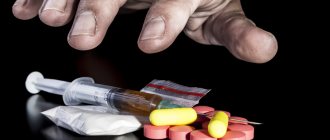Everything related to the illegal trafficking of drugs and substances containing them is under special attention of the Criminal Code (CC) of the Russian Federation. The production, storage, sale and distribution of drugs are criminal offenses (what is the sentence for selling drugs, read here). It is worth noting that the sentences for the listed acts are differentiated depending on the size of the batch of narcotic substances with which the offender was detained. Let's consider what a particularly large, large and significant amount of drugs is, and what punishment is provided for in the Criminal Code for various actions with drugs.
Criminal Code on illegal drug trafficking
Responsibility for any illegal manipulations with narcotic drugs is prescribed in the Criminal Code of the Russian Federation:
Additionally
If the actions of distribution and sale of narcotic drugs were committed by a minor, then no criminal case will be brought against him. However, in this case, the minor is registered with law enforcement agencies.
- illegal production, possession of drugs under the Criminal Code of the Russian Federation and distribution of drugs containing drugs - Art. 228.1, part 1, punishable by imprisonment from 4 to 8 years;
- distribution of drugs in public places and places of detention, or distribution using the media, including via the Internet - Article 228.1, part 2. Punishment under this article provides for from 5 to 12 years in prison;
- if the listed crimes were committed by several persons in a pre-planned conspiracy, or in a significant volume, then this is Article 228.1, Part 3, which prescribes imprisonment from 8 to 15 years.
Personal drug use is not a criminal offense; this offense is under the jurisdiction of the Code of Administrative Offenses (CAO) of the Russian Federation. Article 6.9 of the Code of Administrative Offenses provides for such an offense a fine of 4,000 to 5,000 rubles or 15 days of arrest. Citizens of another country in case of such a violation are subject to deportation outside the Russian Federation. It should be taken into account that everything said applies only to those who use drugs illegally, that is, without a doctor’s prescription. More information about liability for the use of narcotic substances can be found in the article https://lexconsult.online/6377-privlechenie-k-otvetstvennosti-za-upotreblenie-narkosoderzhashhih-veshhestv.
It is worth noting that possession of drugs containing drugs is a criminal act, therefore, almost everyone who uses drugs stores them for some time, and therefore commits a crime under Art. 228.1.
Criminal liability for possession of marijuana
26.12.2018 (68362)
Marijuana in the Russian Federation is included in the list of prohibited substances No. 1, completely withdrawn from civil circulation. The penalty for marijuana possession depends on the amount of weed found by law enforcement and the purpose for purchasing or manufacturing it. Possession of any narcotic drug for the purpose of sale, in accordance with the law, is punished more severely than for personal use. If the weed is intended for personal use and is found in small quantities, the culprit faces administrative liability - a fine or administrative arrest. Criminal liability for possession of marijuana purchased for personal use begins with a significant amount (6 g).
What is marijuana and its effect on the body
Marijuana is a drug obtained from the stems and leaves of cannabis with the addition of a small amount of flowers. The active substance is THC, which is found in marijuana at 0.5-4%.
Addicts sometimes add marijuana to food for an intoxicating effect, but the main way to use it is through smoking. For this purpose, a rolled-up cigarette (joint) or a cigarette is used, in which tobacco is replaced with weed. Inhaled smoke containing THC enters the bloodstream through the lungs and spreads throughout the body, resulting in drug intoxication.
The active substance of marijuana, after entering the bloodstream, begins to act almost immediately, the maximum effect is achieved after half an hour, and the duration of action is 2-4 hours, depending on the concentration of THC and the sensitivity of the body.
Characteristic features of cannabinoid drug effects:
- euphoria;
- general muscle relaxation, feeling of lightness;
— violation of spatiotemporal perception;
- unreasonable uncontrollable laughter;
- hyperesthesia of sound, color and taste stimuli.
In a state of drug intoxication after consuming marijuana, the perception of things changes: colors become brighter, individual sounds merge into music, food becomes even tastier, etc. The passage of time slows down or, on the contrary, accelerates, social activity increases - a person becomes sociable and talkative.
In combination with alcohol, a feeling of impending danger may appear, anxiety and panic may arise. General lethargy appears, thought processes and memory are disrupted.
Effect of marijuana on human organs:
- brain - has a negative impact on short-term memory, the ability to understand what is happening, abstract thinking and learning;
- lungs - causes the negative effects characteristic of tobacco smoking, on an increased scale - pharyngitis, bronchitis, sinusitis, cancer, edema, the development of various diseases of the upper respiratory tract.
- heart - increased blood pressure, increased heart rate;
- reproductive system - hormonal imbalance, decreased testosterone and increased number of abnormal cells in sperm in men, ovulation disorders and toxic effects on the fetus in women.
Marijuana can accumulate in the female genital organs and disrupt the development of the fetus; mothers who smoke marijuana give birth to children with reduced weight - “fetal marijuana syndrome,” which is observed 5 times more often than “fetal alcohol syndrome.” When feeding infants, the drug passes through the mother's milk into the child's body. Weed can cause unpredictable effects in people with heart defects and those suffering from cardiovascular diseases.
Marijuana impairs coordination of movements; after smoking “weed,” the reaction to sound and light signals slows down, the degree of perception and the ability to perform sequential operations decreases. The drug addict develops a need to actively move and talk, and when at rest they take unnatural positions.
Marijuana acts more mildly than hard drugs, but ultimately causes the same consequences - destruction of health and personality degradation. The consequences of drug use can be mental disorders - apathy, depression, suicidal tendencies. In the absence of weed, a state of extreme discomfort appears, which forces you to constantly increase the dose.
Marijuana leads to rapid addiction, and then to the need to increase the dose, followed by a transition to stronger drugs. Medical studies show that in almost all cases, users of heroin, crack and other “hard” drugs started with marijuana. Cannabis and all drugs based on it are included in List No. 1 of the UN Convention and relevant legislative acts of the Russian Federation and are prohibited from free circulation.
Long-term use of marijuana leads to serious disruptions in the functioning of the brain and vital systems in humans. The only positive effect of marijuana is that by blocking pain receptors, it can provide a powerful analgesic effect.
Punishment for possession of marijuana
Possession of marijuana means the very fact that it is in the possession of a certain person. In this case, the storage location and duration do not matter. The drug can be seized from the offender’s home, car interior, bag, clothing pockets, etc.
If detected, a medical examination of the detainee is carried out; the presence of the drug in the blood is automatically equated to the use of marijuana and entails administrative punishment with subsequent registration at a drug treatment clinic. If more than 6 g of marijuana (a significant amount) is detected, a criminal case is opened under Art. 228 - illegal possession, use and transfer of psychotropic and narcotic drugs without the purpose of sale. If it is established that the culprit in one way or another participated in the distribution of marijuana, he faces a criminal case under Article 228.1. Inducing other people to use marijuana in any form is Article 230 of the Criminal Code of the Russian Federation.
Cultivation of hemp is also a crime; for growing a small number of plants, you face administrative liability, and for finding more than 20 plants on your personal property, there is a criminal penalty.
Liability for possession of marijuana is determined by a number of articles of the Criminal Code and depends on the specific situation and the totality of mitigating and aggravating circumstances (if any).
The punishment can be mitigated by voluntary surrender of weed, a certificate of health problems, or positive references at the place of work or residence. Mitigating circumstances during a criminal investigation also include the presence of dependent young children and some other factors.
Articles for possession of marijuana
Marijuana is one of the most common drugs used through smoking. The use of weed falls under Article 6.9 of the Administrative Code, which provides for punishment in the form of a fine in the amount of 4-5 thousand rubles or 15 days of administrative arrest. The statute of limitations for the offense is 1 year; if a foreigner is caught with “weed,” he will be expelled from Russia. Parents are responsible for a child caught with marijuana (Article 20.22 of the Criminal Code of the Russian Federation). An additional hassle of being caught with drugs is registration at a drug treatment clinic. A person is released from administrative liability for possession of marijuana if he voluntarily surrenders the “weed” in his possession and goes to a medical institution for treatment for drug addiction.
Upon possession of marijuana on a large or especially large scale, a criminal case is initiated in accordance with Art. 228 of the Criminal Code of the Russian Federation.
Article 228 provides for liability for illegal transactions with narcotic and psychotropic drugs, their analogues and plants containing psychotropic and narcotic drugs. At the legislative level, the acquisition, storage, processing and transportation of narcotic drugs is prohibited.
Article 228, part 1 for possession of marijuana in a significant amount provides for liability: a fine of up to 40 thousand rubles or in the amount of the offender’s income for a period of up to 3 months, correctional labor for up to two years, up to three years of imprisonment and up to 480 hours of compulsory labor.
If marijuana is found in large quantities, in accordance with Art. 228, part 2, the perpetrator faces imprisonment for a term of 3 to 10 years, with restriction of freedom for a period of up to 1 year or without it, with a fine of up to 500 thousand rubles or in the amount of the income of the convicted person for a period of up to three years or without it.
The punishment for possession of “grass” on an especially large scale is imprisonment for a term of 10-15 years with or without a fine of up to 500 thousand rubles, with or without restriction of freedom for a term of up to 1.5 years.
The note to the article for possession of grass (Article 228 of the Criminal Code of the Russian Federation) discusses the conditions for releasing the guilty person from liability. The perpetrator may be released from criminal liability if all the conditions are simultaneously met:
— there was a voluntary surrender of the drug;
— providing assistance to law enforcement agencies in solving and preventing crimes in the field of drug trafficking, exposing persons who have committed or are committing a crime;
— assistance in detecting funds obtained by criminal means.
It is considered that voluntary surrender of drugs has occurred if their owner transferred prohibited drugs to law enforcement agencies when he had the opportunity to dispose of the drug differently. If the marijuana was seized during arrest or during the investigation, then the voluntary surrender will not be counted by the court.
Large and especially large sizes of narcotic drugs are established by the Government of the Russian Federation.
Administration of the city of Oboyan
Classification of drug batch sizes
The drug batch size can be:
- significant - the weight of a substance that exceeds a single dose of use. If the weight of a drug is less than the established norm for a specific type of drug, then such a crime is classified as an administrative offense and is regulated by the Code of Administrative Offenses;
- large – the weight of the drug suitable for distribution;
- especially large – wholesale size of a batch of narcotic substances.
We present quantitative indicators that correspond to the above classification in a summary table. These standards are established and approved by Decree of the Government of the Russian Federation No. 1002 dated October 1, 2012.
| Significant, (g) | Large, (g) | Extra large, (g) | |
| marijuana (dried hemp) | 6 | 100 | 100000 |
| amphetamine | 0,2 | 1 | 200 |
| heroin | 0,5 | 2,5 | 1000 |
| soporific poppy (dried) | 20 | 500 | 100000 |
| spices (mixtures) | 0,05 | 0,25 | 500 |
As can be seen from the table, the established volumes for various types of drugs differ significantly from each other, and are directly dependent on the severity of the damage caused to human health. Therefore, just a quarter of a gram of spice is already considered a large size, and for marijuana a large size is from 100 g.
It is worth noting: if there is a need to determine the size of a mixture consisting of several components, then the definition of significant, large and especially large size is applied to the drug in the mixture for which the legislator has established more stringent control measures. Moreover, the position of the Supreme Court is that the size of the narcotic substance is equal to the weight of the mixture itself. If the size of solutions or liquids is determined, they are evaporated at a temperature of 70-110 degrees, and then the dry residue is measured.
Where to report
When faced with the sale of psychotropic or other illegal drugs, people often simply do not know where and how to report information. You can report illegal activities:
- using the addresses and telephone numbers from advertisements or billboards of the Federal Drug Control Service placed in populated areas;
- anonymously by federal or local telephone;
- police officers or prosecutors.
An anonymous message can also convey information. The only condition is a clear indication of the source of information. Reports of the sale of narcotic drugs are carefully checked by law enforcement officials.
Qualification
The classification of offenses is determined taking into account the methods of distribution as follows:
- without specific signs;
- using communication means (regular or mobile phone, on the Internet);
- in organizations, institutions, enterprises;
- in correctional institutions, in pre-trial detention centers;
- in public places;
- a group of distributors in collusion;
- organized group;
- the trafficker of the drug is an official;
- an adult dealer sells/offers drugs to a minor client.
Offenses have different severity, and the preventive measure, accordingly, varies. Depending on the qualifications, a court verdict may determine punishment in the form of:
- prohibition to hold certain positions for up to 20 years;
- payment of a fine of up to 1 million rubles or in the amount of income for 5 years;
- restrictions of freedom up to 2 years;
- imprisonment for various periods.
We suggest you read: Rental agreement for parking space
The punishment for a criminal who sells drugs depends on the circumstances of the particular crime.
What else you need to know
Every addict is a potential seller. When a person abuses psychoactive substances, he rapidly degrades; he has only one need left - for another dose. Addicted people often become distributors. If there is such a person in the family, it is important to cure him of his addiction as early as possible, so that one day you do not see a family member in the dock.
It’s good when a person can realize in time the harm of drug addiction. In this case, he has every chance of being cured of his addiction (for example, using the 12 Step program). And then drugs will disappear from his life forever.
Attention!
The information in the article is for informational purposes only and does not constitute instructions for use. Consult your healthcare provider.
Definition
In the legislative formulations, the phrase “drug distribution” does not exist; it is replaced by the term “sale.” The sale/distribution of psychotropic substances and narcotics means any action that results in the transfer of a substance prohibited by the legislation of the Russian Federation from one person to another. In fact, anyone who carries drugs is considered a distributor:
- offered as a treat;
- gave;
- sold;
- used to pay off debt, etc.
Possession of drugs: article, term, punishment, criminal and administrative liability
International conventions, laws at various levels, rules and regulations - drug circulation (storage, etc.) is subject to many different documents. Failure to comply with regulations is a crime. Let's look at the specifics of the crime and find out what article for drug possession is provided for in the legislation of the Russian Federation.
Who usually possesses drugs illegally? People who are just “dabbling” or are already addicted. Distributors (sellers) of various levels, as well as all those associated with the prohibited, but very widespread drug business.
This is a very real prospect for every marketer. Any paragraph of Article 228.1, as well as the second part of Article 228.2, provides for deprivation of liberty. It all depends on what criminologists call qualifying features. They determine the severity of the crime. If the dealer simply sold the dose somewhere in a dark alley, this is one crime, less serious. Trading in a nightclub, stadium, or public transport will result in more severe punishment.
How much time can a person convicted of drug distribution receive? At a minimum, four years in prison. Even without any aggravating circumstances, this term can increase to eight years. Even an experienced lawyer cannot predict in advance how long a person will be “imprisoned.” The court takes into account a huge number of nuances: whether the defendant is new or has already been prosecuted before, what age he is, what he does, even how he behaves in court.
If drugs are sold by an entire organization, in large quantities, to children under eighteen years of age, and so on, then the prison term increases noticeably, including at its lower limits. Some drug trafficking cases result in sentences ranging from fifteen to twenty years in prison.
Drug distribution: characteristics of the crime
Distribution of drugs is a criminal offense. It is worth noting that such a term as “distribution” is absent in legal norms; instead, the term “sales” and forwarding is used. This is exactly the terminology used in Article 228.1. Criminal Code.
Lawyer's opinion
Dmitry Ivanov
Legal Support Center
This article talks about typical ways to resolve the issue, but each case is unique. If you want to find out how to solve your particular problem, call:
Or on the website. It's fast and free!
Art. is devoted to certain aspects of drug distribution. 228.2 of the Criminal Code. It contains a description of the punishment for violating the current rules for the sale and dispensing of narcotic drugs. The subject of such a crime can only be special. This is a pharmacy pharmacist, pharmacist, doctor, employee of a specialized laboratory.
The public danger of the spread of drugs is that their unpunished sale has an extremely negative impact on
health of citizens
, socio-psychological atmosphere, law and order, economy and other areas of public life.
The subject of this crime is:
- narcotic drugs of natural and synthetic origin;
- psychotropic substances;
- their analogues;
- plants containing narcotic/psychotropic substances or parts thereof.
The list of narcotic substances subject to control is contained in Government Decree No. 681 of 1998, Single Convention on Narcotic Drugs of 1961, Art. 12 of the UN Convention against Illicit Traffic in Narcotic and Psychotropic Substances.
Illegal drug sales are any methods of transferring narcotic drugs to other persons for a fee or free of charge. It means sale, gift, loan, exchange, payment of debt and alternative methods of sale (for example, injection).
Sales cannot be understood as the following actions:
- getting rid of drugs by leaving them in a certain place or throwing them in the trash;
- injecting another person if the drugs belong to him;
- purchase of drugs by an intermediary in an amount that is commensurate with individual consumption using the consumer’s funds and at his request (in this case we are not talking about sales, but about assistance);
- purchasing narcotic drugs to help an animal.
The presence of a crime can be indirectly indicated by: a significant amount of narcotic drugs, a preliminary agreement with the consumer, an industrial method of production, specific packaging, etc. To initiate a criminal case and bring criminals to justice, it does not matter where exactly the sale of drugs was planned: on the territory of the country or beyond.
The sale of narcotic drugs is considered completed from the moment they pass into the possession of another person. Moreover, the form of transfer of prohibited substances can be any and does not affect the qualification of the crime (for example, hiding places, transfer through the fence of the colony, use of animals, third parties, etc.).
The illegal transfer of drugs means their movement to the recipient without direct participation in the movement of the sender. For example, by mail, by parcel, by air or other means of transport. Responsibility for delivery begins from the moment the letter, luggage or parcel containing drugs is sent.
The elements of the crime are formal; the crime is considered completed from the moment of commission of any of the considered actions.
The subjective side of the crime is characterized by direct intent, that is, the criminal is well aware of the social danger of the acts committed.










